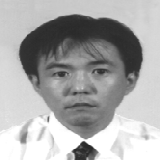

|
Jun ToyouraTRC Information Integration
Laboratory |
Profile
| Affiliation:
| Information Integration Laboratory
Theory and Novel
Functions
Department |
| Date of birth:
| May 29, 1962 |
| Birthplace:
| Tokyo |
| Background:
| |
| 1986
| Graduated from the Department of Physics, Faculty of Science,
University of Tokyo |
| 1989
| Left in mid-course of the
Doctorate Course, Postgraduate
School of Physics, University of Tokyo |
| 1989
| Joined NEC |
| 1991
| Joined Mitsubishi Electric Corporation |
| 1994
| On loan to RWCP Tsukuba Research Center |
My relation with "Tsukuba" may go back to when I was a high school student.
When I entered high school, its name was changed to "Affiliated High School of
University of Tsukuba" from "Affiliated High School of University of Education."
My honest impression was "why it should be named after such a rural place"
because the high school was located in Tokyo, not in Tsukuba.
Several years later, I joined the High Energy Institute in Tsukuba* to do
experiments on physics while I was on a postgraduate course. At that time,
highway bus services were not available. So, I traveled by train named
Joban-line from Tokyo to Tsuchiura, the nearest station to Tsukuba, and took
local bus to the city center. I made this little journey many times. Living in
the city for half a week forced me to learn "how to live in Tsukuba" with
reluctance.
And in 1994, I was again appointed to a post in Tsukuba. Frankly, I
anticipated that the city might have been changed a great deal after ten years
have passed. I found, however, that Tsukuba was still a strange combination of
"urban" and "suburban" landscape. When you are stationed in such an environment,
you feel like adopting a more healthy lifestyle. Once you allow yourself to have
such a lifestyle, you can never return to the hassle and bustle of modern cities
like Tokyo. So, I'm determined not to acquire a "Tsukubaniac" lifestyle and
spending my days in a very unhealthy manner.
My job? Oh, yes. I'm now engaged in research on information bases at the
Information Integration Laboratory of Tsukuba Research Center. Recent years have
witnessed a remarkable development of information infrastructure. In particular,
a word "Internet" became one of the most popular words in Japan last year and we
can now access virtually any kind of information we want. It can be described as
a new "Era of Exploration in the Information World." Our mission is to develop
navigation technology on the sea of information.
Suppose I have a CD-ROM containing newspaper articles for one year (about
100,000 articles). This will be the base for our discussion of information
navigation.
First, we search the database using the keyword "Tsukuba" written in kanji
characters. We find nine articles all of which are about "University of Tsukuba"
or "Mt. Tsukuba" (both are usually written in kanji). Then, we will make another
search with the keyword "Tsukuba" in hiragana letters. We hit 40 articles. Most
of them are about the city of "Tsukuba" (the city name is always written in
hiragana). The original nine articles are not selected.
This means that, from a computer's point of view, "Tsukuba" in kanji and in
hiragana are quite different things. So, the computer cannot find articles about
"Tsukuba" in kanji with the keyword "Tsukuba" in hiragana and vice versa. To
make the search possible, the computer must know that the two "Tsukubas" in
different scripts are synonyms. A set of synonyms, antonyms, and related words
is called a thesaurus. The thesaurus is an effective compass for information
navigation. Since the sea of information is constantly changing, our thesaurus
should be continually updated. For example, "Morihiro Hosokawa-Prime Minister"
should be changed to "Tsutomu Hata-Prime Minister," "Tomiichi Murayama-Prime
Minister" and finally "Ryutaro Hashimoto-Prime Minister." One of the primary
objectives of our research is to establish the automatic creation of such a
thesaurus on a computer.
Another method of navigation is possible by utilizing overall similarity of
articles themselves rather than linguistic relations. For example, you would
select a certain article (subject) and "look for any related articles in all
data from the past year." To identify this similarity among articles,
multivariate analysis and other methods would be needed to set up an appropriate
space for expressing significance. This is the difficulty we are faced with.
We now plan to have a demonstration at the RWC Symposium to be held in 1997.
* When I joined the High Energy Institute, the name "Tsukuba" in hiragana was
not yet in use. See if you can identify which "Tsukuba" is used for the
following names: the kanji or hiragana version? (1) Tsukuba Mitsui Building (2)
Tsukuba Bank (3) Tsukuba Ham (4) Minami Tsukuba Golf Club

